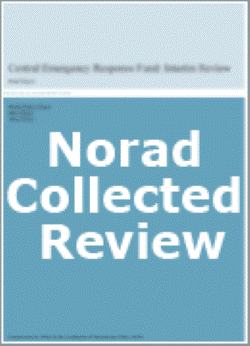Mid-term Review of: The Environmental Cooperation Programme between Norway and South Africa 2005-2010
Om publikasjonen
- Utgitt: november 2009
- Serie: Norad-innsamlede rapporter
- Type: --
- Utført av: Tore Laugerud, Nordic Consulting Group (NCG), team leader; Matthew J. Smith, Strategy & Tactics, South Africa
- Bestilt av: Royal Norwegian Embassy, Pretoria
- Land: Sør-Afrika
- Tema: Klima og miljø
- Antall sider: 154
- Serienummer: 16/2009
- ISBN: 978-82-7548-449-7
- ISSN: --
- Prosjektnummer: Ras 04/293

NB! Publikasjonen er KUN tilgjengelig elektronisk og kan ikke bestilles på papir
The Project
The cooperation between Norway and the republic of South Africa (RSA) in the environmental sector has been ongoing since 1994, through three phases. Phase three, the current program started in 2005, with a total Norwegian contribution up to 40 million NOK for the period 2005-2010. The programme goal is to promote sustainable development through the protection and conservation of natural resources, safeguard the environment from pollution, and enhancing the quality of the environment. The programme is covering key aspects within three themes: Pollution and waste; Environmental Governance; and Biodiversity & Conservation.
Interesting Findings
- There is relatively consistent set of goals and purposes developed for the Programme and the three main themes thereunder: 1-Pollution & Waste; 2-Environmental Governance; and 3-Biodiversity and Conservation. The individual projects have, to a very limited degree, developed logframes following the LFA method, with the waste projects under Theme 1 where State Pollution Control Authority (SFT) is involved is the notable exception. This lack of consistent logframes has however not restricted or hampered the project implementation, although the lack of quantifiable indicators make outside monitoring difficult, as progress is measured against activities only. Properly planned projects according to the LFA modality is neither a guarantee of success for the project, as clearly seen with the waste projects. Allowing sufficient time for planning the project and for the partners to develop proper ownership to the efforts is even more important.
- The implementation of the Programme might be characterized as fairly satisfactory, with some projects doing really well (the ones in eThekwini, within Air Quality Management, and within Red Listing/biodiversity and biosafety), and some having not performed at all (notably the ones on waste management, and to a large extent Youth & Environment). It is noted that a couple of the projects in the Programme has not received any funding from Norway at all during Phase III, even though they are still on the project list (Knowledge Sharing Networks and Wetlands Inventory under Theme 3). Almost all the projects have experienced delays in the implementation, a risk that was not elaborated from the start. It is also realised that the activity level and the extent of bilateral cooperation between Norwegian and South African partners has gradually decreased during Phase III, after having experienced the most intensive period of cooperation during Phase II. This is also the desired scenario in terms of the Norwegian development cooperation perspective, which will end in its present form naturally at the end of Phase III.
- The list of positive effects from the Programme must be attributed both to Phase II and III, with the most tangible results being in Phase II, especially with regards to the capacity building of South African staff. The staff at DEAT (Department of Environmental Affairs and Tourism) and in eThekwini Municipality especially have to a large degree reached a competence level making them independent of foreign personnel cooperation assistance, although they might have challenges in staff turnover, as educated staff are seeking greener pastures or are promoted. It is also observed that the South African staff to a large degree are not using their Norwegian counterparts as advisors and partners in dialogue any more, but merely want the Norwegian side to be “services providers” (consultants) delivering concrete outputs. This will have a clear bearing on the cooperation under a possible New Programme. In general, the scientific results delivered in the Programme (when delivered) have a very high quality, and the project partners to a large extent construe each other to be on similar professional level internationally. The cooperation between the partners, however limited, has been satisfactory seen from both parties, with very few exceptions. It is realised that Ministry of Environment has several roles in the Programme, which should be critically reviewed when the possible New Programme is designed.
- Some shortcomings are observed in the Programme, especially connected to the functions of Theme Managers, who have little interaction with the projects. The document management in the Programme (notably DEAT) is not satisfactory with too many activities being changed and documents being poorly marked/nominated. There is a discrepancy between the amounts reflected in the financial management system of DEAT and those records kept at the project level, mainly due to the time lag when amounts are recorded in the books and the coding being wrongly entered. Expenditure in the Programme has been lower than planned, mainly due to project delays in implementation. Institutional cooperation between the two countries is clearly not sustainable without Norwegian funds to cover the Norwegian part.
Publisert 20.11.2009
Sist oppdatert 16.02.2015
